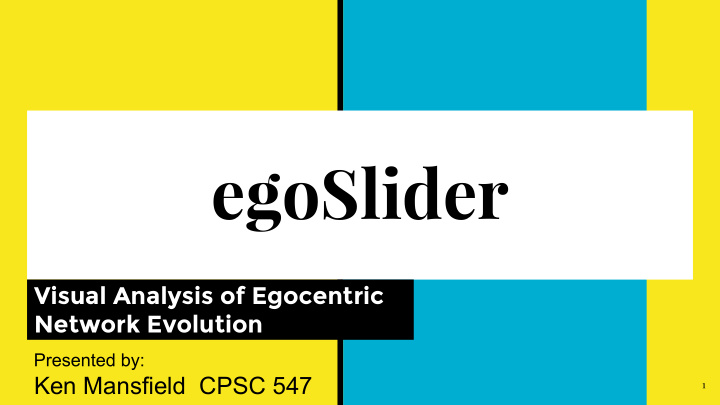



egoSlider Visual Analysis of Egocentric Network Evolution Presented by: Ken Mansfield CPSC 547 1
Why: Social Network Analysis Egocentric-Networks represent relationships between a specific individual - the ego - and the people connected to it, known as - alters . Why? Investigating information flows and people relationships. Understanding how networks evolve over time. 2
Why: Related Work Most works focus on 1-level ego-net formed by ego and 1 degree alters. These do not capture the changes over time. Idiom : Node-Link Macro-overview (many ego’s) or Micro (1-ego + alters). 3
Why: Social Network Analysis Need a new way to investigate correlations between topology of ego-nets and the ego’s characteristics: Structural Hole Theory : an individual may gain strategic advantages over others when his or her alters are highly seperated and have a relatively low connection density. Romantic relationships between two people (ego’s) can be recognized based on what extent that their mutual friends (alters) are well-connected. 4
Some Terms: Tie Strength : Defined by the linear combination of time, emotional intensity, intimacy and reciprocity (i.e. mutuality). Density : The proportion of direct ties in a network relative to the total number possible. Structural holes : The absence of ties between two parts of a network. Finding and exploiting a structural hole can give an entrepreneur a competitive advantage. 5
Who? Social network analysis has emerged as a key technique in modern sociology . Also: anthropology, biology, communication studies, economics, geography, history, information science, organizational studies, political science, social psychology, development studies, sociolinguistics Now commonly available as a consumer tool. 6
Other Tools: EgoNet (below) Gephi(right) 7
What: Social Network Data Extract ego-network structure from raw dataset such as citation networks. Filters and characterizes with features for measuring similarities. 8
What: Social(?) Networks Data sourced from DBLP (computer science bibliography). Parsed and stored on MongoDB. +52k papers on Info Viz - 64k authors Also tested on Enron(!) emails. 9
How: Angular JS and d3. 3 Views created each aimed at addressing specific questions. 10
How: Broken down into 3 seperate visualizations. Data Overview: Macroscopic view of all Ego’s Timeline Summary View: Mesoscopic view for comparing the alter networks between different Ego’s. Alter Timeline View: Microscopic view for viewing an Ego’s relationship with its alters. 11
Scatter Macroscopic Level: Plot Contour Plot Questions: 1. What are the overall patterns at each time step. 2. What are evolutionary trends of a large group of people’s ego net’s. 12
Macroscopic Level: Clusters of Ego’s, MDS layout Idiom : Contour Plot Encoding : the “elevations” are related to their number of alters Doesn’t do anything else. 13
Macroscopic Level: Where individual ego’s exist within the clusters. Idiom : Scatterplot, Manipulate (select/highlight), Small multiples for different years. Encoding : Darker points have more connected alters. Red points are the Ego’s selected for viewing in the Micro/Meso views. Highlighting to show that Ego’s place in the clusters over time. 14
Mesoscopic Level Questions: 1. What are general similarities between multiple people’s ego net’s over time? 2. Differences between multiple people’s ego net’s at a specific time-step? 15
Mesoscopic View: Idioms : Pie Charts, Bar Charts Encoding : Colours, line widths. a. Pie b. Bar 16
Mesoscopic View: Mousing over the pie chart. Encoding : Red = Increase, Blue = Decrease Mouse over centre of Pie = density. Change View to Bar Chart 17
Microscopic View: Questions: 1. How does the number of an ego’s 1-2 degree alters change over time. 2. How do the tie strengths evolve. 3. How are the alters of an ego connected over time. 18
Microscopic View: a. 1 degree alters b. 2 degree alter volume flow. c. A new 1 degree alter who was previously 2 degree. 19
Microscopic View: d. Alter becomes ego’ s 2-degree neighbor - returns to 1 degree after several timesteps 20
Microscopic View: Can look at the an Ego’s connection to their Alter’s individually. Encoding : Highlighting an individual alter on the micro view allows you to follow the Ego’s connection to an alter over time. Colour Encoding remains the same as other views. 21
Microscopic View: Encoding Mousing over the pie chart will link to the alters on the view below (and make it larger) Encoding : Alter bar position is based on the tie strength. 22
User Study: 15 students, 12 questions. Micro and Meso views only. Baseline Viz: small multiples with Ego in the centre and alters around it (node- link). Accuracy: egoSlider: 92.5%, baseline: 83.6% Time: egoSlider: 16.76s, baseline: 19.55s 23
Criticisms? Scale? Tested with up to 150 Alters. Would not work well with 500+ ● Slow? There was no loading spinner so I thought it was broken. ● Visual overload with many ego’s. ● Awkward UI. ● Big learning curve. ● No Instructions. ● Overall I like it. 24
http://vis.cse.ust.hk/egoslider/ 25
egoSlider: Visual Analysis of Egocentric Network Evolution Questions? by: Yanhong Wu, Naveen Pitipornvivat, Jian Zhao, Sixia Yang, Guowei Huang, and Huamin Qu 26
More recommend